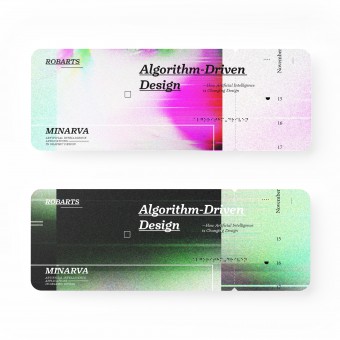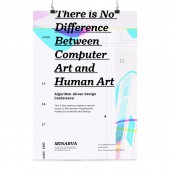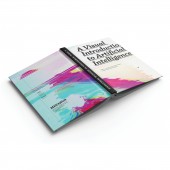
| THE AWARD |
| CATEGORIES |
| REGISTRATION |
| SUBMIT YOUR WORK |
| ENTRY INSTRUCTIONS |
| TERMS & CONDITIONS |
| PUBLICATIONS |
| DATES & FEES |
| METHODOLOGY |
| CONTACT |
| WINNERS |
| PRESS ROOM |
| GET INVOLVED |
| DESIGN PRIZE |
| DESIGN STORE |
| THE AWARD | JURY | CATEGORIES | REGISTRATION | PRESS | WINNERS | PUBLICATIONS | ENTRY INSTRUCTIONS |
Artificial Intelligence in Design Event Marketing Material by Min Huei Lu |
Home > Winners > Design #120552 >Interview |
 |
|
FS: What is the main principle, idea and inspiration behind your design?
ML: RESEARCH SUMMARY Summary There is a lot of controversy around Artificial Intelligence, Machine Learning, and the use of specific goal-oriented algorithms to shape the future of design and the designer’s role. But how will that affect our careers as graphic and digital designers in the long run? Definition explanation A.I. Technology has two unique characteristics. First, it exhibits capabilities that ordinary machines don’t have. Second, it exhibits an intelligence that allows learning by itself. A.I. enables computers the faculty of gaining knowledge and exhibiting human behavior. With the help of computers, A.I. can now do the tasks that humans used to be able to do. Some interesting facts about AI Is A.I. capable of creating art? The answer could surprise you. Let me introduce the Alibaba Group’s A.I. graphic design product called LuBan. It is an A.I. platform that is capable of designing 8,000 different banners per second. On November 11, 2017, LuBan displayed over 400 million online banners during China's biggest online shopping festival. If we assume that it takes one human designer 20 minutes to design a single banner, we will need 100 designers to work continuously for 150 years just to produce the same number of banners. The issue We designers already have one question in mind: What will be the future of graphic designers?” This thesis’ target audience is the designers of the future.
FS: What has been your main focus in designing this work? Especially what did you want to achieve?
ML: I have found that A.I.’s information can be difficult to understand. I want to provide people with a basic understanding of A.I. with an interactive and engaging digital publication. The future of A.I. will identify patterns in the image to patch, edit, create stimulating visual styles, personalize the user experience, and analyze huge amounts of data. Low-level design jobs will be eliminated. Investing in retraining or “upskilling” designers is an urgent priority that corporations, educators, or individual workers should be taken into consideration. I propose to create an organization that will provide retraining and re-skilling to help reduce the learning curve. Instead of seeing A.I. as a threat to the design profession, A.I. can help designers do things better than the way they do them now. High-level designers have to compensate by learning to work with A.I. It is time we start recognizing these opportunities so we can work better with technology. I want to design A.I. services and platforms to help graphic designers enhance our creativity, society, and relationships with the rest of the world.
FS: How long did it take you to design this particular concept?
ML: Artificial Intelligent in Graphic design project is the Academy of Art University of Graphic Design’s Master of Fine Art thesis project, which took 2 years to develop. The thesis project emphasizes the advanced study of the field by conducting quantitative and qualitative research, focus group, inspiration, ideation, prototyping, and user-testing.
FS: Why did you design this particular concept? Was this design commissioned or did you decide to pursuit an inspiration?
ML: There have been a lot of discussions about Artificial Intelligence, Machine Learning, and utilizing algorithms that will shape the future of design and the role of designers in general. However, its impact on our careers as graphic and digital designers is still unknown. At a recent Tedx event, the futurist Thomas Frey predicted that 2 billion jobs would disappear by 2030 – that’s 50 percent of all jobs. According to a report by Oxford University and Deloitte, 800,000 jobs were lost in the UK due to automation between 2001–2015. However, according to the same report, 3.5 million new jobs were created. NPR’s “Will your job be done by a machine?” predicts an 8 percent chance of a graphic designer’s job being automated within 20 years. What could the future be for graphic designers? Adaptability is a fundamental design principle for all future designers. AI will become a design partner and tool that designers can use in an ever-evolving role. Designers should set up a growth mindset to adapt to the evolving role. The first step is to understand AI’s existing tools and capabilities. Furthermore, designers should weave AI ethics into the creative process. As AI continues to change and affect the way we design, our roles will evolve as well. Now, it’s just a matter of viewing AI as being less of a threat and embracing it more as a partner that helps extend our ability to tackle problems.
FS: Is your design being produced or used by another company, or do you plan to sell or lease the production rights or do you intent to produce your work yourself?
ML: The Artificial Intelligence In Graphic Design campaign was promoting a 3-day conference in San Francisco, CA in November 2019. Each day there is a design workshop, with talks from different speakers. The goal behind this event is to help designers understand what Artificial Intelligence is and how to work with Artificial Intelligence to achieve something bigger in the creative industry.
FS: What made you design this particular type of work?
ML: The thesis, named, Minarva aims to engage technology in a meaningful way by enhancing the ability of the designers. Reclaiming to the designers that instead of feeling threatened by AI, we should take advantage of technology by understanding the potential of AI. Redefining the relationship between humans and machines is crucial. AI will help the design industry clarify the boundary between creative and productive work. If a computer can resize an advertisement in 50 formats, the designer can focus on the strategic aspects of the next campaign. Reinforcing the idea that AI is not a threat but in fact a huge opportunity for the design world.
FS: Where there any other designs and/or designers that helped the influence the design of your work?
ML: In order to get more insight and a better perspective, focus groups may include designers, engineers, data scientists, and computer scientists, as well as other experts, have no background in A.I. but still have a vested interest in it. These other groups may consist of business professionals, law students, and scientific researchers. Over thirty people in related fields attended the event.
FS: Who is the target customer for his design?
ML: This thesis’ target audience is the designers of the future.
FS: What sets this design apart from other similar or resembling concepts?
ML: I always try to avoid using robots to represent the images that I generate because they are so cliche.
FS: How did you come up with the name for this design? What does it mean?
ML: We are currently in the early stages of A.I. development. According to research, human beings are known to be skeptical about what A.I. is ultimately capable of. Despite this notion, people have always relied on the convenience that A.I. has brought them. Many are worried that A.I. will make humans become less economically viable. In German the meaning of the name Mina is love. Minerva was the Roman goddess of wisdom, arts, trade, and strategy. That is why I decided to name this thesis project Minarva because the primary purpose of this thesis is to develop a meaningful human-machine relationship between graphic designers and A.I.
FS: Which design tools did you use when you were working on this project?
ML: A.I. Image generator, A.I. Logo generator, Adobe After Effect, Adobe Premiere Pro. Adobe Photoshop, Adobe Illustrator, Adobe Indesign, Adobe XD.
FS: What is the most unique aspect of your design?
ML: I have been exploring many A.I. image generator applications that have already been published online. I tried to understand the level of quality of an A.I. image generator could deliver. I have been testing two different websites. The A.I. Image generators will allow anyone to become digitally creative and get the most out of their images. I was genuinely impressed by these experimental design methods because A.I. generated a new image effectively. It took less than an hour to process an image, and it allowed me to process an unlimited number of images and it was free. I used the images that have been generated by A.I. to design posters. I took some images that have been generated by A.I. and used Adobe Photoshop to split the RGB colors and added some image noise and glitch effects. As a result, I created a unique visual language by using the collage technique.
FS: Who did you collaborate with for this design? Did you work with people with technical / specialized skills?
ML: I interviewed A.I. expert, Luigi Nardi, Ph.D., Assistant Professor in Machine Learning at Lund University; Research Scientist at Stanford. He participated in the focus group and gave an inspirational speech.
FS: What is the role of technology in this particular design?
ML: With the help of A.I. and technology, I created multiple designs for this project at much faster rates and reduced costs. There are a lot of surprising ways that A.I. can be used in graphic design such as speedy design prototyping, A/B testing, analyzing vast amounts of data, suggesting design adjustments, resizing, product localization, creating variations, and creating the same graphics in multiple languages. AI/ML transcription dutifully translates a sketch to comp and into markup. Transferring sketches into a working prototype is part of the designer’s job, but that is not the real thinking. Designers have already solved the conceptual part of the problem, and we share these solved problems with machines so we can solve new ones. The clerical parts of our work perhaps we find painful, the tedious job is the time-consuming, repetitive, detail-oriented, error-prone, joyless job. However, machines are great at those jobs. Human designers and robots should be able to work together side by side and do wonders.
FS: Is your design influenced by data or analytical research in any way? What kind of research did you conduct for making this design?
ML: After clearly defining the problem statement, I conducted several research activities to understand the background, context, and audience to discover key insights. I also looked at visual and conceptual opinions from diverse sources to generate ideas. The research phase included two parts, primary and secondary. Conducting research is an inquiry-based process that involves identifying a question, gathering information, analyzing and evaluating evidence, drawing conclusions, and sharing the knowledge gained. The ability to conduct research is critical skill students need to be college and career-ready.
FS: What are some of the challenges you faced during the design/realization of your concept?
ML: It was very intimidating the first time I read the news title, “Artificial intelligence generated 8000 posters in 1 second”. The first thought that came into my mind: Is A.I. taking over the graphic designers’ job. When I moved forward with the thesis process, all the articles were either too complicated or too confusing, especially for a designer with no computer science background. The MFA thesis process is like jumping into the rabbit hole, but I’m so glad I did! Developing new visual language for A.I. and technology is also very challenging.
FS: How did you decide to submit your design to an international design competition?
ML: By participating in a prestigious design competition, I have a new opportunity to show critical thinking and creative skills. The rewards of design competitions help me achieve both my educational and professional goals.
FS: What did you learn or how did you improve yourself during the designing of this work?
ML: When A.I. started to make a logo (Logojoy) and poster (Luban), build U.I. (UIzard), mockup (Placeit), and website (WIX). Designers freak out, “omg is A.I. taking over a designer job?” No, That is not our job, that is the clerical part of our job. That’s the production job that dutifully translates sketch to comp and into mockup, this is not the real creative thinking; this is not a conceptual strategy made by a designer. Some tedious design jobs like re-sizing, translating, and prototyping are time-consuming, repetitive, detail-oriented, error-prone, and joyless. We designers even feel a little bit pained to do those kinds of jobs which the computer is actually very good at! Let A.I. take over the joyless part, and web designers can move on to solve the next design problem! When humans and A.I. work together, it actually could make some interesting combinations that generate new insights.
FS: Thank you for providing us with this opportunity to interview you.
A' Design Award and Competitions grants rights to press members and bloggers to use parts of this interview. This interview is provided as it is; DesignPRWire and A' Design Award and Competitions cannot be held responsible for the answers given by participating designers.
| SOCIAL |
| + Add to Likes / Favorites | Send to My Email | Comment | View Press-Release | Translations |




